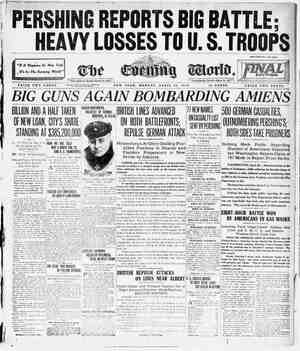The Nonpartisan Leader Newspaper, April 22, 1918, Page 3
You have reached the hourly page view limit. Unlock higher limit to our entire archive!
Subscribers enjoy higher page view limit, downloads, and exclusive features.
— Y e gy N b R E P! | - 2 1 W Wit , ¥ 3 % o~ { e N I3 (.* ¥ - ) ~ & < - IJ "y o = i Y - { . iy b & St £ } P A . g ‘v 0 U 51 1 v’ ol A ] . other states were treated 30 years ago. oo In the interest of a square deal for the farmers VOL. 6, NO. 16 onparfisan Teader Olficml Magazine of the National Nonpartisan League ST. PAUL, MINNESOTA, APRIL 22, 1918. A magazine that dares to print the truth WHOLE NUMBER 135 Kansas and N. D.—A Striking Parallel Politicians and Profiteers Raised the Same Charges Against the Farmers’ Alliance .7 30 Years Ago That They Now Raise Against the Nonpartisan League A view of Topeka and the Kansas state capitol. It was in this bmldmg that the victorious Kansas farmers in 1891 were cheated of the fruits of their victory be- cause of a reactionary senate. The tall white building in the distance, slightly to the left of the capitol, is the Santa Fe railroad building. BY RALPH L. HARMON WIN birthplaces of two great farmer uprisings—that of 1890 and that of 1916—North Da- kota and Kansas, share the honor of being hounded ‘as “anarchist” and “seditious” states. Their people have been libeled by enemy politicians and newspapers for similar reasons. Personal wtuperatxon of the leaders runs parallel in both instances.. Abuse, falsehoods and finally plug-ugly secret organization agamst the move- ment, marked its development in both cases. So strlkmg is the parallel between these two states in pioneering the way for great upheavals of ‘the farmers and workers, that it is almost nncanny— ‘Nonpartisan leaguers of today can have no more interesting glimpse of 'the past than to see how members of the Farmers’ alliance of Kansas and People of Kansas can have no better inkling into the motives ~back of the present attack upon the Nonpartisan ""league than® to compare the two movements and the opposition they aroused. . The people of the entire nation wfll have a clearer vision of the real issues when they learn by a glance backward at Kansas history. Farmers were called v“tra:tbrs” in 1890 just as they are now in 1918, - for joining a.farmers’ organization.. ‘no war'in: 1890,—-—there had been no war tor‘25 years 2 There was Kansas in 1890 played upon wartime prejudice by charging members of the Alliance with being “rebels,” just-as today they are playing on war- time prejudice by charging members of the League with being “pro-Germans.” The old parties united against the farmers’ movement in Kansas, just as * they are doing today against the farmers’ move- ment that originated in North Dakota. They never argued the real issues, but fought their political battles on trumped-up charges reeking with class prejudice. They denied the political and economic ‘outrages that gave birth to the Alliance, just as they today deny the encroachments of big business that have brought the Nonpartlsan league into being. HOW THE ALLIANCE CAME INTO BEING But let us start at the beginning ‘and unravel this almost forgotten story of old Kansas. To Kansas ‘above all other states belongs the distinc- tion of having been the spot where the Alliance movement was born. Some histories of the Farm- ers’ alliance, failing to delve deeply enough into the past, spesk of a “southern” and 'a “northern” - Alliance, and gwe Texas credit for bringing forth the first, and Illinois credit for the other. But to Kansas belongs the ancestry of both these seem- ingly different moventents, and linked up with this big fact is the wartime profiteenng of the railroads and land-owning interests of.the '60s, who took:-ad- vantage:of the: Civil war to clench: theu' talons in a bleedmg }mtxon Nearly one-fifth of the area of Kansas in 1868 was embraced in the great Osage reservation, an /empu‘e of .over 8,000,000 acres of the richest farm- ing land on the continent. Upon this land under pre-emption rights there lived more than 10,000 farmers and their families tilling the soil and bring- ing civilized prosperity into the waste. Adjoining this land to the east were 800,000 acres more nominally belonging to the Cherokee Indians and supporting nearly 5,000 American farmers. Into this budding paradise of the farmer there crept the stealthy scouts of America’s first profi- teers—the railroads—greedy for land and promis- ing the country to build railroads in return for land. But they tried to get these two great areas without even the pretext of building railroads. They framed up a “treaty” with the Osage Indians . by which a private syndicate headed by far eastern capitalists bought the Indian title for a -mere pittance, and then went into congress and had this ratified by the senate. They then secured, through official crookedness, the government title on their own terms and at prices they fixed ‘themselves. The story of their methods is black. They told the Indians the governor of Kansas (Samuel J. Craw- ford at that-time) would drive them off with militia if they did not sign. They pulled every wire in congress to have the deal consummated before the people awakened. The story is too long to tell and is mterestmg here -only as having caused ‘the people of Kansas’ to form small who lived upon the Osage lands to ( T ———






